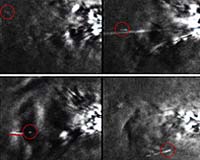| . |  |
. |
Paris, France (ESA) Oct 17, 2007 In the early morning on 14 October, the Double Star TC-1 satellite, the first scientific spacecraft built and operated by the Chinese National Space Administration (CNSA) in cooperation with the European Space Agency (ESA), returned to Earth after completing its designed orbit lifetime. Operated together with its twin TC-2 and the four satellites of the ESA Cluster mission, TC-1 has been a highly successful scientific mission. It re-entered the Earth's atmosphere and disintegrated during its descent. The Double Star Program (DSP) mission is the first collaborative scientific mission between CNSA and ESA. The dual-spacecraft mission is dedicated to investigating global physical processes in Earth's magnetic environment and its response to solar disturbances. The first spacecraft, TC-1, was launched on 29 December 2003 and the second one, TC-2, on 25 July 2004, both on board Chinese Long March 2C rockets. TC-1 was injected into an equatorial orbit and TC-2 into a polar orbit. The orbits have been designed to complement the Cluster mission by maximizing the time when both Cluster and Double Star sample the same scientifically interesting regions at different distances from the Earth. Together, the two missions allowed simultaneous observations of the Earth's magnetosphere from six points in space.
Science Highlights A large number of papers have appeared in the literature since the Double Star launches. A special issue of Annales Geophysicae on the first Double Star results was published in November 2005. A special issue of the Journal of Geophysical Research on the latest results of Double Star and Cluster is under review and will be published in the coming months. Since most of Double Star papers are associated with Cluster data, all papers are combined in a single list. As of September 2007, this list contains 978 papers, among which 683 are refereed papers. Here are some of the major results where TC-1 played a crucial role.
Space is fizzy
Celestial chorus further away Listen to the celestial chorus here
Oscillations of Earth's natural cloak of magnetism "Double Star has demonstrated mutual benefit and fostered scientific cooperation in space research between China and Europe. But there is still much more to come as the full, high-resolution data archive becomes available," says Philippe Escoubet, ESA's Cluster and Double Star Project Scientist. Double Star is CNSA's first scientific mission and also the first in collaboration with ESA. The mission consisted of two spacecraft investigating global physical processes in Earth's magnetic environment and their responses to solar disturbances. The mission has lasted four years, surviving way past its nominal lifetime of one year. ESA contributed to the development and pre-integration of eight European instruments for the mission. Ground station support was provided with the download of data for four hours each day using the Vilspa-2 ground station near Madrid, Spain. ESA also coordinated the scientific operations for the European instruments, via ESTEC and the European payload operations service at Rutherford Appleton laboratory, UK. CNSA's contribution included the two spacecraft buses, eight other scientific experiments, and the launches. CNSA was in charge of spacecraft control and operation of the Chinese instruments. After its nominal lifetime of one year, operations of Double Star were extended twice by both agencies until the end of September 2007. A large number of papers have appeared in the literature since the launch of Double Star. A special issue of Annales Geophysicae on the first Double Star results was published in November 2005. A special issue of the Journal of Geophysical Research on the latest results of Double Star and Cluster is under review and will be published in the coming months. As of September 2007, the combined list of Cluster and Double Star consists of 691 scientific papers. Community Email This Article Comment On This Article Related Links Double Star in depth Cluster in depth Cluster overview Double Star overview SOHO overview Solar Orbiter Space weather Double Star - First Results [2005] Solar Science News at SpaceDaily
 Washington DC (SPX) Oct 02, 2007
Washington DC (SPX) Oct 02, 2007NASA's STEREO satellite captured the first images ever of a collision between a solar "hurricane", called a coronal mass ejection (CME), and a comet. The collision caused the complete detachment of the comet's plasma tail. Comets are icy leftovers from the solar system's formation billions of years ago. They usually hang out in the cold, distant regions of the solar system, but occasionally a gravitational tug from a planet, another comet, or even a nearby star sends them into the inner solar system. |
|
| The content herein, unless otherwise known to be public domain, are Copyright 1995-2007 - SpaceDaily.AFP and UPI Wire Stories are copyright Agence France-Presse and United Press International. ESA Portal Reports are copyright European Space Agency. All NASA sourced material is public domain. Additional copyrights may apply in whole or part to other bona fide parties. Advertising does not imply endorsement,agreement or approval of any opinions, statements or information provided by SpaceDaily on any Web page published or hosted by SpaceDaily. Privacy Statement |